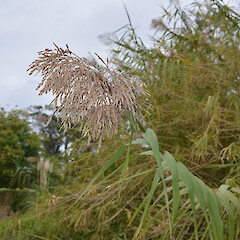Arundo donax
Common name
giant reed
Family
Poaceae
Flora category
Vascular – Exotic
Structural class
Grasses
NVS code
The National Vegetation Survey (NVS) Databank is a physical archive and electronic databank containing records of over 94,000 vegetation survey plots - including data from over 19,000 permanent plots. NVS maintains a standard set of species code abbreviations that correspond to standard scientific plant names from the Ngä Tipu o Aotearoa - New Zealand Plants database.
ARUDON
Conservation status
Not applicable
Habitat
Often aquatic. Emergent. Moist forest communities, lowland and coastal forest, streamside and gully communities, intertidal areas, shrublands, alluvial areas, roadsides, farm hedges, wastelands, domestic gardens, coastal areas in general. Prefers areas where the soil does not dry out completely.
Detailed description
Clump-forming bamboo-like grass to 8 m. Root mass dense, rhizomes short. Stems hollow, erect, becoming semi-lax, woody. Leaves alternate, 30–90 × 5 cm, parallel veins, bamboo-like, bluish-green (white-striped form is common in cultivation). Seedhead terminal, fluffy.
Similar taxa
Similar dimensions to Phragmites australis, but Arundo has leaves arranged in two rows, while Phragmites does not. Generally looks like a leafy bamboo, but has much larger leaves arranged in two rows.
Flowering
April
Life cycle
Perennial. Arundo produces loose clumps of lateral rhizomes, which are thickening underground stems that produce new shoots and plants at intervals along the stems. Little or no seed set in New Zealand. Spreads by rhizomes. Broken stems may occasionally resprout. Dispersed by water and soil movement, garden dumping.
Year naturalised
1936
Origin
Eurasia, Europe, N Africa
Reason for introduction
Ornamental
Tolerances
Tolerant of very wet soils, intolerant of drought.
National Pest Plant Accord species
This plant is listed in the 2020 National Pest Plant Accord. The National Pest Plant Accord (NPPA) is an agreement to prevent the sale and/or distribution of specified pest plants where either formal or casual horticultural trade is the most significant way of spreading the plant in New Zealand. For up to date information and an electronic copy of the 2020 Pest Plant Accord manual (including plant information and images) visit the MPI website.














